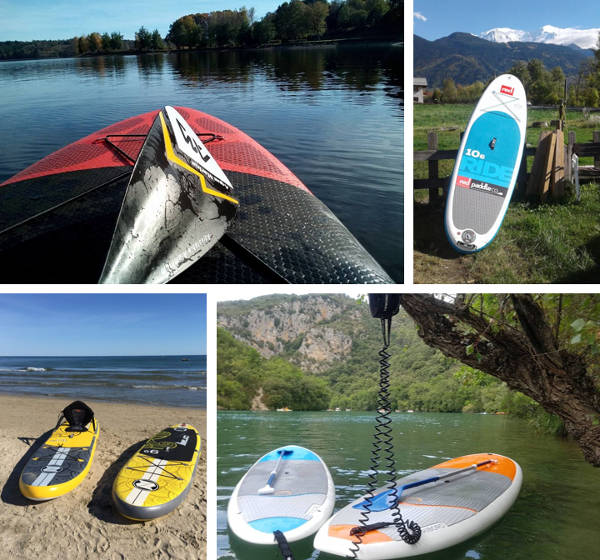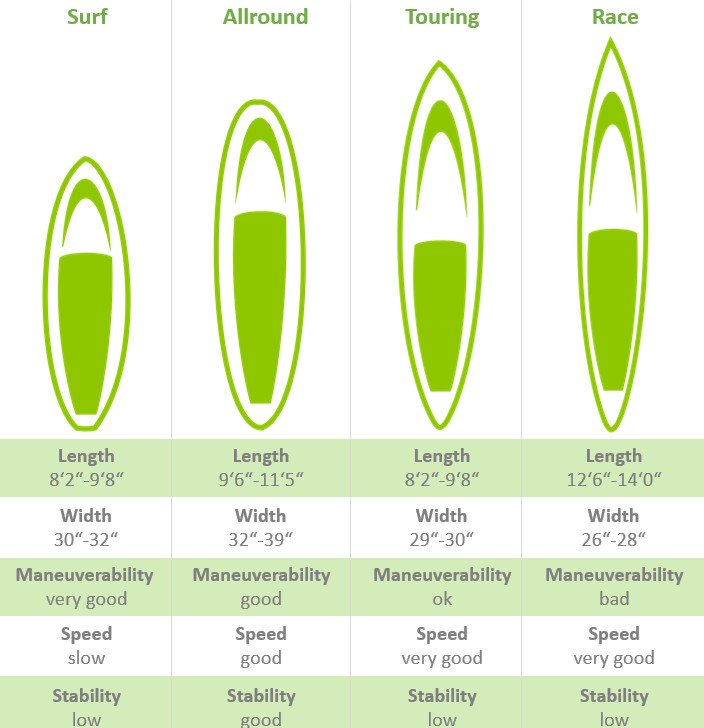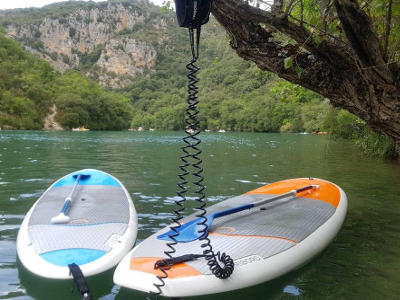Stand-Up Paddling, or just SUP, enjoys huge popularity in the recent years. Whether enjoying on the nature lakes or rivers or discovering cities like London or New York, Stand-Up Paddling is everywhere omnipresent and their possible uses are nearly endless.

SUP is not only something for sport enthusiasts with paddle experience. Quite the contrary, everybody you can stand stable and knows how to swim can do Stand-Up paddling.
The range of Stand-Up paddle boards is getting larger and larger and the before buying a SUP you can feel really overwhelmed by all the SUP boards that are on the markets. Each board has its own characteristics and is consequently designed for different uses. In this article we tell you what you should know before buying your SUP board in order to find the right board.
Possible uses of Stand-Up Paddle
There are generally speaking four different fields of applications for SUP boards: Surf, touring, racing and fitness. The two main disciplines are touring and fitness. As beginner you will probably pick one of these two disciplines. Surf or Wave is in contrast rather a discipline for advanced or pros.
Touring can be understood to be mean to cover a longer distance. For someone who prefers discover lakes and rivers and who wants to get from A to B with the board should go for a touring board. Such a board offers also some space for luggage. When purchasing one you should pay attention that your board comes with a luggage net.
The one or other may ask what fitness Stand-Up paddle means. In the recent years yoga and pilates groups have been formed in nearly all big cities, which do their courses during summer outside with a SUP board on the water. The board is literally replacing the training mat and the fact of being in the nature increases incredibly the relaxing atmosphere. Those boards are very tip-resistant.
Surf or wave is a SUP discipline that is not really made for beginners. It requires a good technique with a good confidence and stability on the board. Sport enthusiasts in this category prefer rather hard shell boards instead of inflatable boards.
All in all there are also some overlaps between the different type of boards. Therefore, there are all-round boards, which have a larger fields of application and they represent a good compromise for everybody who doesn’t know what particular board might be the right one. If you are looking for a board on which you can do your yoga exercises, then an all-round board is also the right choice for you.
The graphic below gives you an overview how long and how wide your board should be in terms of your desired use. We can only give you ranges since it depends also on your weight. In the following section we are going to explain to you which impact the length, width and thickness have on the drive characteristics.

Solid or inflatable Stand-Up Paddle Board
Inflatable Stand-Up paddle boards, or just iSUP, are the current trend. In contrast to hardhsell SUP boards they offer a huge advantage. They can be easily transported with a backpack and you can take them everywhere you like. Consequently, they require also much less storage space and fit easily in every cave. The advantage of an iSUP to get to remote places open countless possibilities. Since they are softer the injury risk is also lower when falling on it. As bathing platform they are also perfect for children.
Despite all the advantage of an inflatable SUP board, there will be still those who prefer hard shell laminated boards. Especially, professional paddler coming from the surf and race area appreciate the feel if a highly responsive, rigid board which lead to a better driving experience. A solid board is also more durable and easier to repair. There is also not time for the set up required.
Nevertheless, we have to mention, that a lot has changed in the segment of inflatable SUP in the recent years. The composition of a high number of fibers, which are glued and interweaved between the lower and upper side. Thanks to this construction iSUP can be inflated with very high pressure and have a better rigidity than years ago.
Inflatable SUP for beginner
For a beginner the advantages of an inflatable SUP outweigh any little advantages. That’s why you should better go for a iSUP. Only if you want to get professional in race or surf you should consider a solid SUP.
SUP board length
From the board length the use for the board is determined. A long board is perfect for long distance tours or as a race board. The shorter the board, the better its stability. A short board is the right choice for fun, fitness paddler or for families. A short board is a also a way slower because it displaces less water. With a longer board you are much faster and his agility is much better but it is less stable.
SUP board width
The width plays also an important role when it comes to stability. The larger a board, the more stable it lays on the water. The wider a board, the slower it is. On the other hand it means that a narrow board is faster but less stable.
Stability depends also on the edges of the heck and the hull. Inflatable boards have typically rounder thicker edges than solid ones and what make them more wonky. That’s why it’s recommended to choose a 1-2 inch wider board in comparison to a solid board. The shape of the hull and tail influences also the stability. Wide and round hull and tails are more stable than boards with a sharp and narrow hull and stern.
SUP board thickness
Regarding the thickness the weight is a quite important factor. Normally boards have a thickness between four and six inches. For paddler under 60kg or for children boards with a thickness of 4 inches are completely sufficient. All others should choose rather a thicker board, ideally 6 inches.
Thinner boards are thanks to their lower volume more stable and manoeuvrable. But thin boards have the disadvantage for heavier persons that water gathers much easier on the surface due to the deflection. For that reason thinner SUP boards are often a way shorter, so that they don’t loose their stiffness. However, when buying a board with a length starting from 11 feet it should a quite thick board. Especially cheap and low quality boards try to save on this fact.
Conclusion
When buying a Stand-Up paddle board there are plenty of things to consider. Information and recommendations may vary between manufacturers and dealers since there are still many different opinions about this quite young trend sport. As a beginner you should go for a inflatable all-round board to stay flexible in terms of uses.
Often you can hear or read that you should invest at least 1000€ in a SUP board. In principle it’s quite true that boards in this price range have a better quality but this high investment might be not necessary for a absolute beginner. This kind of high acquisition cost may deter a beginner from buying one and consequently they will never try it out. Especially, when you are not sure whether this sport is the right one for you in the long run or not, you are better investing between $400 and $600. Later on, when you know exactly your needs and requirements you can invest more in the right board. And it will be still possible to sell the old board on ebay for example.
